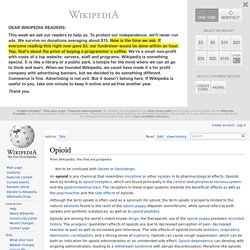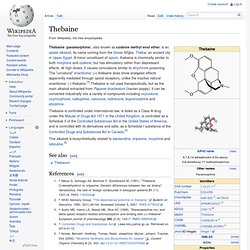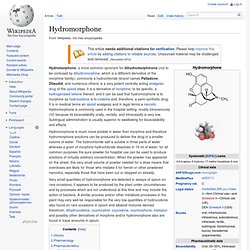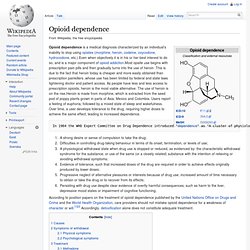

Opioid. An opioid is any chemical that resembles morphine or other opiates in its pharmacological effects.

Opioids work by binding to opioid receptors, which are found principally in the central and peripheral nervous system and the gastrointestinal tract. The receptors in these organ systems mediate the beneficial effects as well as the psychoactive and the side effects of opioids. Although the term opiate is often used as a synonym for opioid, the term opiate is properly limited to the natural alkaloids found in the resin of the opium poppy (Papaver somniferum), while opioid refers to both opiates and synthetic substances, as well as to opioid peptides.
Opioids are among the world's oldest known drugs; the therapeutic use of the opium poppy predates recorded history. The analgesic (painkiller) effects of opioids are due to decreased perception of pain, decreased reaction to pain as well as increased pain tolerance. Medical uses[edit] Oxycodone. Oxycodone is a semi-synthetic opioid synthesized from poppy-derived thebaine.

It is a narcotic analgesic generally indicated for relief of moderate to severe pain. It was developed in 1916 in Germany[4][5] as one of several new semi-synthetic opioids in an attempt to improve on the existing opioids.[1] Oxycodone is available as single-ingredient medication in immediate release and controlled release. Combination products formulated with non-narcotic ingredients such as NSAIDs and paracetamol (acetaminophen) are also available as immediate release formulations. Medical uses[edit] Oxycodone has been in clinical use since 1917,[1] and it is used for managing moderate to moderately severe acute or chronic pain.[6] It has been found to improve quality of life for those with many types of pain.[7] In 2001, the European Association for Palliative Care recommended that oral oxycodone could be taken as a second-line alternative to oral morphine for cancer pain.[10]
Thebaine. Thebaine (paramorphine), also known as codeine methyl enol ether, is an opiate alkaloid, its name coming from the Greek Θῆβαι, Thēbai, an ancient city in Upper Egypt.

A minor constituent of opium, thebaine is chemically similar to both morphine and codeine, but has stimulatory rather than depressant effects. At high doses, it causes convulsions similar to strychnine poisoning. The "unnatural" enantiomer (+)-thebaine does show analgesic effects apparently mediated through opioid receptors, unlike the inactive natural enantiomer (-)-thebaine.[3] Thebaine is not used therapeutically, but as the main alkaloid extracted from Papaver bracteatum (Iranian poppy), it can be converted industrially into a variety of compounds including oxycodone, oxymorphone, nalbuphine, naloxone, naltrexone, buprenorphine and etorphine. This alkaloid is biosynthetically related to salutaridine, oripavine, morphine and reticuline.[5] Morphine biosynthesis See also[edit] Thebacon.
Hydromorphone. Hydromorphone, a more common synonym for dihydromorphinone (not to be confused by dihydromorphine, which is a different derivative of the morphine family), commonly a hydrochloride (brand names Palladone, Dilaudid, and numerous others) is a very potent centrally acting analgesic drug of the opioid class.

Opiate. Harvesting the poppy pod.

In medicine, the term opiate describes any of the narcotic opioid alkaloids found as natural products in the opium poppy plant, Papaver somniferum.[1] Overview[edit] Opiates belong to the large biosynthetic group of benzylisoquinoline alkaloids, and are so named because they are naturally occurring alkaloids found in the opium poppy. The major psychoactive opiates are morphine, codeine, and thebaine. Papaverine, noscapine, and approximately 24 other alkaloids are also present in opium but have little to no effect on the human central nervous system, and as such are not considered to be opiates. While the full synthesis of opiates from naphthoquinone (Gates synthesis) or from other simple organic starting materials is possible, they are tedious and uneconomical processes.
Terminology[edit] The alkaloids[edit] Morphine[edit] Chemical structure of morphine Morphine addiction cure advertisement in the year 1900. Opioid dependence. Opioid dependence is a medical diagnosis characterized by an individual's inability to stop using opiates (morphine, heroin, codeine, oxycodone, hydrocodone, etc.)

Even when objectively it is in his or her best interest to do so, and is a major component of opioid addiction.Most opaite use begins with prescription pain pills and then gradually turns into the use of heroin .This is due to the fact that heroin today is cheaper and more easily obtained than prescription painkillers ,whose use has been limited by federal and state laws tightening doctor and patient access. As people have less and less access to prescription opioids, heroin is the most viable alternative. The use of heroin is on the rise.Heroin is made from morphine, which is extracted from the seed pod of poppy plants grown in parts of Asia, Mexico and Colombia. Users report a feeling of euphoria, followed by a mixed state of sleep and wakefulness.